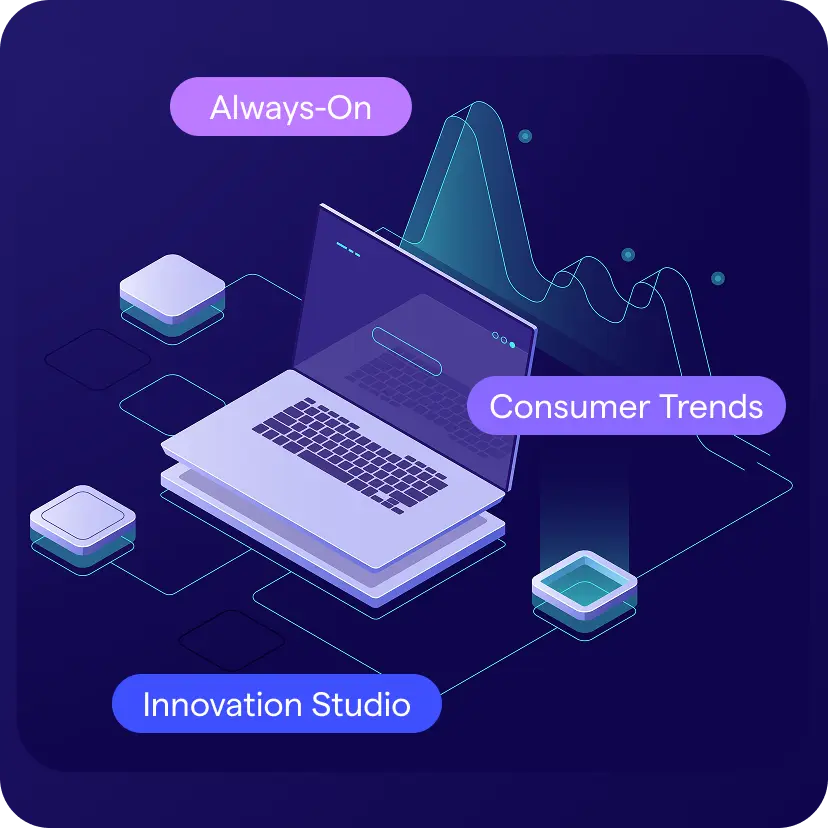If you struggle with your product launch strategy, you’re not alone — and there’s a common reason for that. Product launch failure rates remain stubbornly high across industries, representing billions in wasted investment and countless missed opportunities. The stakes are high for enterprises in industries like CPG, which are under pressure to innovate consistently and introduce new products at a particularly high rate, as 30% of revenue must come from new products to stay a market leader in CPG, a McKinsey article revealed. However, despite significant investments in market research capabilities and extensive customer data, enterprise organizations continue to struggle with failed product launches at an alarming rate.
However, the root cause isn’t a lack of data or research investment. It’s the presence of critical blind spots that leads to incomplete market understanding. These blind spots create significant gaps between what organizations believe they know about their markets and the actual reality that their customer base experiences, directly contributing to the startlingly high rate of product launches failing to meet their mark. According to Clayton Christensen, a professor at Harvard Business School, it’s often because they don’t address a real market need. Furthermore, this lack of clarity extends beyond outright failure, with a Gartner survey revealing that 45% of product launches are delayed by at least one month, frequently due to issues stemming from a poor understanding of market requirements and internal challenges. These figures underscore the profound impact of failing to bridge the gap between perceived and actual market understanding.
Below, we’ll examine the specific blind spots that derail even the most well-funded product launches. We’ll also discuss why comprehensive market understanding is essential for success and uncover the best strategies for overcoming product launch failure.
The critical blind spots of market understanding often missed
Despite substantial investments in market intelligence, organizations frequently overlook fundamental areas that are critical for successful product validation and launch. These critical blind spots often stem from outdated practices, fragmented research data, or an over-reliance on a narrow view of market reality, leading to a distorted understanding of genuine opportunities and risks.

A closer look reveals distinct blind spots that consistently impede successful product launches:
- Misreading customer needs and preferences. Organizations often mistake what customers say they want for what they actually need, leading to products that solve the wrong problems. This misalignment typically stems from over-reliance on traditional survey data without sufficient qualitative insight, resulting in strategies built on assumptions.
- Underestimating the competitive landscape. Many organizations focus too exclusively on direct competitors, failing to recognize indirect competition or shifting market dynamics. This tunnel vision prevents truly differentiated positioning and can lead to launching products into markets more saturated or contested than initially understood.
- Ignoring market dynamics and evolving trends. Product launch decisions are often based on static snapshots of market conditions rather than dynamic, ongoing analysis of industry trends and customer behavior shifts. This creates a dangerous lag between market reality and internal assumptions, particularly problematic for products with long development cycles, often resulting in launch dates coinciding with unfavorable market conditions.
- Internal misalignments and unchecked assumptions. Cross-functional teams often operate with different assumptions about target customers, market size, and success metrics, creating internal inconsistencies. These misalignments frequently go undetected, undermining launch effectiveness and confusing messaging. Without reconciliation mechanisms, products launched with internal contradictions dilute market impact.
Recognizing and addressing these prevalent blind spots is the crucial first step toward developing a market understanding that can adequately support successful product launches.
How comprehensive market understanding de-risks launches
A comprehensive market understanding serves as the foundation for a successful product launch by eliminating guesswork and assumptions. When organizations possess deep, accurate, and continuously updated insights into customer needs, competitive dynamics, market trends, and internal capabilities, they can make informed decisions at every stage of the product launch process. This level of market understanding transforms product launches from high-risk gambles into calculated strategic moves with predictable outcomes.
Achieving this level of de-risking involves focusing on several critical areas:
- Building a dynamic and holistic market picture: Building a complete, dynamic market picture through robust, centralized knowledge management (KM) practices enables organizations to maintain a single source of truth for data regarding market conditions, customer insights, and competitive intelligence. All teams can then access and contribute to this one source, ensuring findings consistently inform decision-making across the entire organization rather than remaining siloed.
- Leveraging AI and advanced insights. Advanced AI technology can synthesize diverse market sources, revealing patterns and connections that human analysis alone might miss. These technologies bring together market signals, customer conversations, and competitive intelligence to provide a nuanced understanding of market dynamics and behavior. This deeper understanding informs more precise targeting and positioning decisions.

- Early identification of risks and opportunities: Comprehensive market analysis, driven by insights teams, allows organizations to address problems before they become costly mistakes — and capitalize on opportunities competitors might miss. This proactive approach helps teams anticipate challenges, refine their go-to-market strategy, and optimize their launch plan based on real market conditions rather than assumptions.
- Continuous validation of product-market fit: Facilitating continuous validation of core assumptions and product-market fit throughout the development cycle ensures products remain aligned with market needs, even as those needs evolve. This ongoing validation prevents organizations from launching products that were right for the market at the beginning of development but have become misaligned by the launch date due to changing customer preferences or competitive dynamics.
The ultimate result is a data-driven, evidence-based decision-making process that guides every aspect of the product launch from initial ideation through post-launch activities. This dramatically reduces the risk of failure while maximizing the potential for market success.
Strategies to overcome the blind spots within your market research comprehension
Organizations must fundamentally transform their approach to market understanding to improve their product launch success rates. This means moving beyond traditional research methods toward more comprehensive, integrated, and dynamic systems for gathering and applying market insights. This transformation requires both cultural changes in how teams approach market research and technological investments in platforms and processes that can synthesize complex market data into actionable insights.
The following strategies provide an essential roadmap for building the market understanding capabilities necessary for consistent launch success:
Cultivate a culture of deep market inquiry
Cultivating a culture of deep market inquiry means fostering continuous learning and systematically challenging long-held assumptions. To validate these new perspectives and ensure market understanding stays fresh, organizations must prioritize direct customer engagement, ethnographic research, and qualitative insight gathering.
This provides the rich, contextual understanding that purely quantitative data often misses, leading to more resonant product positioning and effective communication.
For organizations striving to cultivate a culture of deep market inquiry, a robust AI-powered knowledge management system (KMS) is essential. DeepSights™ provides a single source of truth, leveraging AI-powered smart search and semantic capabilities to instantly navigate vast repositories of structured and unstructured data, including qualitative research and customer customer experience data, within your knowledge base. This powerful insights platform helps democratize knowledge, enabling teams to search, synthesize, and share insights efficiently. By transforming raw data into actionable intelligence through generative (gen) AI and automated summarization, DeepSights empowers organizations to continuously challenge assumptions and ensure their market understanding remains current and comprehensive.
Invest in integrated insights capabilities
Investing in integrated insights capabilities means utilizing a modern insights platform that centralizes and connects diverse market information sources, breaking down silos. This type of platform should unify customer feedback, sales insights, competitive intelligence, market research, and customer insights findings into a single view accessible to all stakeholders, ensuring insights consistently inform decisions across the organization.
By employing AI-powered tools, organizations can uncover non-obvious patterns and predictive insights from these combined sources, identifying market opportunities and risks that might otherwise be missed. This capability provides a significant competitive advantage in both product development and launch strategy.
DeepSights empowers organizations to fully realize integrated insights capabilities by unifying diverse market information sources and breaking down silos. Crucially, AI-powered insights within DeepSight’s suite of tools swiftly synthesize this consolidated research data, enabling rapid summarization and trend identification to deliver actionable intelligence that identifies market opportunities and risks in seconds. This ultimately provides a significant competitive advantage, enabling smarter product development and launch strategies from these combined sources.
Implement rigorous pre-launch validation processes
Implementing rigorous pre-launch validation processes ensures products align with market needs and customer expectations before significant launch investments. This involves systematic concept testing, value proposition refinement, and product-market fit analysis that assesses not just features, but also positioning, pricing, and messaging with real target customers.
Additionally, establishing iterative feedback loops with clearly defined segments creates ongoing dialogue. This will enable continuous refinement of both product and launch strategy, and keep internal assumptions grounded in external reality.

Implementing rigorous pre-launch validation processes becomes seamless with DeepSights, transforming your existing market intelligence into a powerful validation engine. The insights platform provides quick access to critical insights on past concept tests, customer feedback, and competitive benchmarks, all of which are essential for refining value propositions and product messaging. Leveraging its advanced AI-powered search and gen AI capabilities, DeepSights delivers immediate clarity on product-market fit by rapidly synthesizing existing knowledge, allowing teams to ground internal assumptions in external reality. By supporting continuous refinement through easily accessible market research data, it significantly minimizes launch risks and maximizes product-market fit.
Enforce cross-functional data sharing and collaboration
Enforcing cross-functional data sharing and collaboration breaks down information silos across R&D, product, marketing, sales, and customer service teams. This ensures insights generated in one area consistently inform decision-making throughout the organization. It also prevents internal misalignments that undermine launch effectiveness.
Achieving a shared, unified market understanding requires ongoing investment in communication, shared metrics, and collaborative planning, enabling all teams to execute more coordinated and effective launch strategies.
Enforcing cross-functional data sharing breaks down critical information silos across teams, and DeepSights facilitates this by providing a centralized hub for all market and customer intelligence via the DeepSights API for seamless data ingestion. This ensures that R&D, product, marketing, and sales operate from a unified understanding, preventing internal misalignments that undermine launch effectiveness. This allows all teams to execute more coordinated and effective launch strategies, directly leveraging DeepSights’ comprehensive insights.
Turning market understanding into a successful product launch with DeepSights
Incomplete market understanding represents a significant and costly risk in product innovation for most organizations, independent of their industry. However, it is correctable with the right strategy, supported by the right AI-powered technology. Organizations that commit to building comprehensive, dynamic, and integrated market insights capabilities can virtually eliminate the blind spots that derail most product launches. The key lies in recognizing that market understanding is not a one-time research activity, but an ongoing organizational capability that requires cultural commitment, technological investment, and systematic processes for gathering, synthesizing, and applying market insights throughout the product development and launch process.

Embracing these strategies transforms market understanding from a periodic activity into a continuous competitive advantage. When organizations successfully implement these approaches — bolstered by AI-powered consumer and market insights — product launches become more predictable, market positioning more compelling, and commercial outcomes consistently successful. A proactive, ongoing commitment to generating deep market insights is the foundation of sustained launch success.
DeepSights brings transformative capabilities in one comprehensive platform, elevating the way your teams achieve successful product launches and sustained business growth. This award-winning, centralized knowledge management system is designed to enhance how your teams capture and analyze data, turning it into actionable insights. Request a demo today to learn more.








